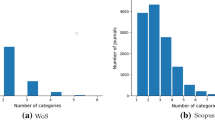Abstract
Subject literature collections are typically formed by judgements which are inexplicit and imprecise. This seems to compromise the worth of precise measurements made of their properties. In this paper an examination is made of how several commonly-measured properties of subject literatures vary as an important factor in the compilation of subject collections is varied. The factor is the amount which a document must ‘say’ about a subject for it to be included in such a collection. This document property has been expressed in formal terms and given a simple measure for the one subject examined, the research topic of Bradford's Law of Scattering. It is found that lowering the level of subject aboutness required for admission to a collection produces a large increase in the size of the collection obtained, and an appreciable change in some size-related properties. For these properties, the initial concern is warranted. However, other parameters are found to be invariant to such changes.
Similar content being viewed by others
References
Aiyepeku, W. O. (1977), The Bradford distribution theory: the compounding of Bradford periodical literatures in geography,Journal of Documentation, 33(3), 210–219.
Bookstein, A. (1990), Informetric distributions, part II: resilience to ambiguity,Journal of the American Society for Information Science, 41(5), 376–386.
Bradford, S. C. (1934), Sources of information on specific subjects,Engineering, 137(3550), 85–86.
Brooks, T. A. (1989), Core journals of the rapidly changing research front of ‘superconductivity’,Communication Research, 16(5), 682–694.
Burrell, Q. L. (1992), The dynamic nature of bibliometric processes: a case study. In:Informetrics—91 Selected Papers from the Third International Conference on Informetrics,I. K. Ravichandra Rao (Ed.), 97–129b. Bangalore.
Egghe, L., Rousseau, R. (1990),Introduction to Informetrics. Quantitative Methods in Library, Documentation and Information Science, Amsterdam.
Hjørland, B. (1992), The concept of ‘subject’ in information science,Journal of Documentation, 48(2), 172–200.
Lockett, M. W. (1989), The Bradford distribution. A review of the literature, 1934–1987,Library & Information Science Research, 11(1), 21–36.
Oluic-Vukovic, V. (1992), Journal productivity distribution: quantitative study of dynamic behavior,Journal of the American Society for Information Science, 43(6), 412–421.
Rousseau, R. (1992), Breakdown of the robustness property of Lotka's law: the case of adjusted counts for multiauthorship attribution,Journal of the American Society for Information Science, 43(10), 645–647.
Salton, G., McGill, M. J. (1983),Introduction to Modern Information Retrieval, New York.
Van Raan, A. F. J. (1990), Fractal dimension of co-citations,Nature, 347(6294), 626.
Wilson, C. S. (1995),The Formation of Subject Literature Collections for Bibliometric Analysis: The Case of the Topic of Bradford's Law of Scattering, Ph.D. Dissertation, School of Information, Library and Archive Studies, University of New South Wales, Sydney.
Author information
Authors and Affiliations
Rights and permissions
About this article
Cite this article
Wilson, C.S. Defining subject collections for informetric analyses: The effect of varying the subject aboutness level. Scientometrics 41, 209–223 (1998). https://doi.org/10.1007/BF02457979
Received:
Issue Date:
DOI: https://doi.org/10.1007/BF02457979




